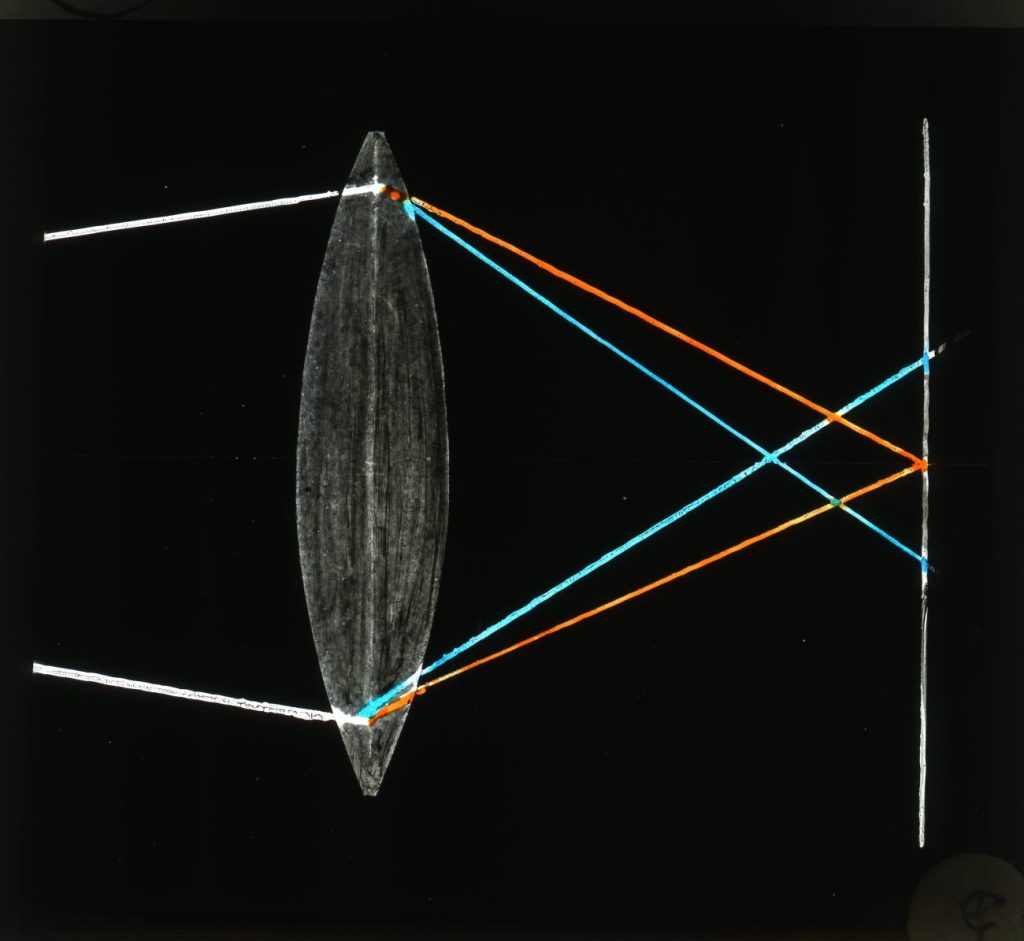Key Points
- Chromatic aberration – Chromatic aberration is when a lens focuses different wavelengths of visible light at slightly different distances. So basically, reds and blues don’t quite line up.
- Lens issue – Chromatic aberration happens because lenses usually work better with some colors than others. The glass bends light different amounts based on its wavelength. And that results in each color focusing a bit off from the others.
- Why different wavelengths – So in reality, different colors of light have different wavelengths. Glass handles the wavelengths in separate ways, which is the actual reason the reds and blues get misaligned. It’s just a lens thing unfortunately.
Contents
Chromatic aberration is an optical problem that occurs when the lens cannot bring all colors to focus on one point. This leads to the image having a colored fringe around it, which is most clearly seen when looking at very high contrast subjects with dark edges. In this post, we will discuss whats the main cause of chromatic aberration and how you can prevent it from happening in your photos.
What is chromatic color aberration (AKA chromatic fringe)

Chromatic aberration also known as chromatic fringe happens when a lens fails to focus different wavelengths of lights onto the same focal plane. It causes a color fringe along with highly contracted regions near the borders, separating dark and bright parts. To understand how it happens, let’s recall what happens when white light passes through a prism from your school physics classes.
If you split the lights into their components, each different wavelength of color (corresponding to a particular frequency and hence the color) strikes the prism at a different angle. The shortest wavelengths (violet end of the spectrum) strike more perpendicularly than longer ones (red end). This makes violet light come out more or less parallel, whereas the longer wavelengths bend and spread out more as they leave the prism. This is called dispersion; it leads to the separation of each color into their respective frequencies, which we observe as a colorful spectrum. This is how chromatic aberration occurs.
The main types of chromatic aberration are axial and transverse.
1) Axial Chromatic aberration:

Image Credit © Soe Lin/CC BY 2.0
Also known as “bokeh fringing” and “longitudinal chromatic aberration” which occurs when different wavelengths of lights do not focus at the same point after passing through a lens. This type will lead to the same color to be blurred along with the entire object. An example of this is purple fringing seen on people’s faces, extending into their hair and beyond.
2) Transverse Chromatic aberration:

Also known as “lateral chromatic aberration” occurs when different wavelengths of light are focused at different distances from the lens. Because different colors of light have different wavelengths, they will be focused at slightly different points as a result. This causes different color variations to come into focus at different points. A good example of this is when you are taking a photo of something with red and blue, the edges of the object will be blurry, but everything else is in focus.
The root cause of chromatic distortion

1) Poor lens quality is a major cause of chromatic distortion (AKA Chromatic Aberration). This is probably the most frequent reason for chromatic aberration. If the quality is poor it can lead to purple fringing on highly contrasted regions of the photo.
2) Uneven aperture blades: This is quite rare these days, but uneven aperture blades can also produce chromatic aberration. You will obviously know if this is happening as you will see that it is affecting many different parts of what’s being photographed rather than just one isolated spot.
3) Incorrectly mounted lenses. It can induce chromatic aberration. If you have a problem with that, return it to the store or technician who sold it to you.
4) Incorrectly adjusted objective lens. Allowing objects other than your target to be in focus will induce chromatic aberration, as everything comes into focus at slightly different points.
5) Cheap camera sensors with poor color reproduction (lower-grade cost-effective sensors). This is often the source of chromatic aberration in low-end DSLRs and is most common in modern lenses. These sensors will not be able to reproduce every color at full fidelity, which will lead to fringing along highly contrasted edges.
6) Using a lens that is designed for another camera brand. Different brands have different color reproduction characteristics, thus it will induce chromatic aberration when used with lenses not specifically designed to work together. This can be prevented by buying the same brand or balancing it out in post-processing software.
7) Light is reflected off the sensor. This is especially true with low-quality lenses, as chromatic aberration can occur on the reflective lights on your camera’s imaging chip. Also, turning on your flash will lead to chromatic aberration as the flash reflected is then refracted into different colors that do not overlap.
8) Out of focus lenses. If the focus is not correct, then the colors will be out of alignment. This can lead to blue color fringing at one end and purple or yellow color fringing on the other side.
9) Distortion from a wide-angle/normal lens focal length in an SLR camera. A short focal length can create distortion that may have the effect of chromatic aberration.
10) Incorrect settings: Incorrect camera settings result in fringing and chromatic aberration. Make sure you confirm there is no problem before taking the picture.
Impact of chromatic aberration
Dispersion has a fairly small impact in most cases with film and particularly when shooting digital.

It also doesn’t matter too much with analog lenses, as the scanners used to scan negatives and prints (which often have imperfections) can mask this type of chromatic aberration rather effectively.
Longitudinal chromatic aberration and red and cyan color fringing in high contrast regions.

This type is more pronounced when using a wide aperture which happens a lot in large format portrait photography. In most cases, however, most photographers don’t notice this as it will be hard to spot if the lens elements is not of good quality.
Lateral chromatic aberration results in purple fringing on high contrast regons

Image Credit © Steve Rainwater/CC BY-SA 2.0
Lateral chromatic aberration has the most impact when taking landscape, portrait, or macro shots. Lateral chromatic aberration is also easier to spot as it will affect only the edges of whatever you’re photographing rather than both sides.
Ways to stop chromatic aberration
Here’s what you can do for chromatic aberration correction:
1) Use a lens hood or move in closer. In most cases, this is the simplest way, as it will reduce reflections due to light being reflected off the CMOS.
2) Increase aperture size. Removing chromatic aberration can easily be done by setting it to low f-numbers such as F/2 or F/2.8. This will lead to a shallower depth of field, but it will also thin the area behind and around whatever your photographing, making chromatic aberration less pronounced.
3) Use one lens for macro and another for “normal” shots. If you have an all-around lens that is great for both close-up and far-away shots, if you encounter chromatic aberration you can keep it at bay by buying a macro lens with a focal length designed to work well with closer images. If this is not an option, utilize the macro feature on your current lens or take closer shots further away from what’s being photographed.
4) Stop shooting high-contrast scenes. This is an excellent way to prevent chromatic aberration from ruining your images, but it may be detrimental to your photography as you will have to sacrifice the spontaneity of certain shots.
5) Center your subject. Once again, this method may ruin the spontaneity of capturing a certain moment. However, by focusing your subject in the center and cropping later, you will be able to eliminate any purple or red fringes around it.
6) Utilize photo editing software. If you have a color fringe in your photo, it can usually be fixed in most photo editing software. Photoshop is great for this purpose, but if not readily available, GIMP is an open-source alternative that will do the job just fine. GIMP even has a chromatic aberration correction filter.
7) Use high-quality lenses. If you are using low-quality ones, chromatic aberration will likely show up in your photos. If possible, it is recommended to buy the same brand of lens and balance out color reproduction issues by adjusting brightness and contrast levels in post-processing software.
8) Use an achromatic lens. Perfect for chromatic aberration correction, it takes the red, green and blue colors, brings them to the same focal point and produce a clear image. They can be expensive to purchase unless your camera has an in-built filter that covers the charge-coupled device (CCD) or complementary metal-oxide-semiconductor (CMOS).
9) Use a variety of light spectrums. Although this is easy to do if you are using tungsten lighting, this may not be an option for other types of film. If you are using different spectrums, one may cancel out the other and thus prevent chromatic aberration from ruining your shot.
10) Use a glass filter. If none of the above methods works for you, consider using a glass filter that is inserted in front of your lens to block out any ultraviolet or infrared lights. There are specific glass filters designed to reduce chromatic aberration at high wavelengths.
11) Change the image to black and white. This is not the best way to decrease chromatic aberration, but it helps correct lateral chromatic aberration and can be an effective method if you are already unhappy with your image. It is also a great substitute for taking high-quality images, as many people prefer black and white photos instead of color ones to begin with.
12) Don’t use zoom lens as varing focal lengths can lead to chromatic aberration. Focal lengths past a certain point is when chromatic aberration starts.
In summary, chromatic aberration can be stopped by adjusting aperture size or stopping down with the use of a lens hood. Using high-quality lenses will also greatly decrease chromatic aberration and balance out color reproduction issues in photo editing software.
Frequently Asked Questions (FAQ)
What are some common causes of chromatic aberration?
Chromatic aberration is commonly caused by the dispersion and refraction of different wavelengths of light as they pass through the multiple elements of a lens. Because of the varying refraction indexes of glass used in lenses for different wavelengths, the point that each color comes to a focus is slightly different.
What different types of chromatic aberration might be seen in a standard photography competition and how can they impact scoring?
Two main types of chromatic aberration seen in photography competitions are lateral chromatic aberration and longitudinal chromatic aberration. Lateral CA happens at the image plane and shows as fringes of color at the boundaries or edges of high-contrast elements in the image. Longitudinal CA results in different wavelengths focusing at different distances, causing different colors to be blurred. Both aberration types can negatively impact scoring by introducing color fringing or lack of sharpness, undermining composition or technical proficiency. Optical engineers at companies like Nikon work to reduce both aberration types through lens design, elements, materials and post-processing corrections.
How did early optic pioneers deal with chromatic aberration before modern lens coatings?
Early optic pioneers like Isaac Newton and Chester Moore Hall struggled with chromatic aberration before solutions like achromatic lens doublets and coatings. They worked to counter longitudinal chromatic aberration through a combination of different lens materials like flint glass and crown glass, whose dispersion partially canceled out. Their efforts laid the foundation for the chromatic correction techniques that make modern exams possible through clear images. While coatings and digital tools help, the core challenge of dispersion among wavelengths remains. Understanding early pioneers’ work with interference, diffraction and dispersion give context to why some level of chromatic aberration persists.
What impact might chromatic aberration have on general science exams involving experiments with lenses and light diffraction/interference, and how can understanding its causes help mitigate problems?
Chromatic aberration could negatively impact general science exams involving experiments with lenses and optical phenomena like diffraction/interference in a few key ways. Different colors focusing at separate distances due to longitudinal CA may blur patterns and readings. Lateral CA fringing around edges could distort measurements of interference/diffraction fringe spacing or spacing of images. Poor color rendition from CA may obscure or disguise important details. However, understanding that aberration arises from dispersion as wavelengths pass through lens elements helps inform solution strategies. Careful selection of lens/sample materials with cancellation dispersion properties helps. Adjusting distances per wavelength prevent blurred readings. Enhanced lighting circumstances make fringe details clearer. Mitigating CA’s varying focal lengths and colors preserves crucial experimental details and accuracy in evaluations.

About Author
Connor Kovack is a Los Angeles based professional photographer & videographer with over 6+ years of experience. Connor is CEO of KovMedia and specializes in Music Videos, Commercials, Photography & More.
